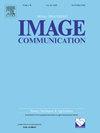Edge-preserving smoothing using the truncated ℓp minimization
IF 2.7
3区 工程技术
Q2 ENGINEERING, ELECTRICAL & ELECTRONIC
引用次数: 0
Abstract
Edge-preserving smoothing is a fundamental task in visual processing and computational photography. This paper presents a nonconvex variational optimization model for edge-preserving smoothing, using a truncated function as the regularization term and the weighted norm as the fidelity term. The truncated function penalizes gradients below a given threshold, while the weighted norm is preferred over the and norms. The proposed model can preserve the salient edges of the input image and eliminate insignificant details. To solve the proposed nonconvex model, we design an effective algorithm based on the alternating direction method of multipliers (ADMM). The effectiveness of the proposed method is demonstrated by a variety of applications, including texture smoothing, clip-art compression artifact removal, image abstraction, image denoising, high dynamic range (HDR) tone mapping, detail enhancement, and flash and no-flash image restoration.
利用截断p最小化的边缘保持平滑
边缘保持平滑是视觉处理和计算摄影中的一项基本任务。利用截断的p函数作为正则化项,加权2范数作为保真项,提出了一种保边平滑的非凸变分优化模型。截断的∑p函数惩罚小于给定阈值的梯度,而加权∑2范数优于∑1和∑2范数。该模型可以保留输入图像的显著边缘,消除不重要的细节。为了解决所提出的非凸模型,我们设计了一种基于乘法器交替方向法(ADMM)的有效算法。该方法的有效性通过多种应用得到了证明,包括纹理平滑、剪贴画压缩伪影去除、图像抽象、图像去噪、高动态范围(HDR)色调映射、细节增强以及闪光和无闪光图像恢复。
本文章由计算机程序翻译,如有差异,请以英文原文为准。
求助全文
约1分钟内获得全文
求助全文
来源期刊

Signal Processing-Image Communication
工程技术-工程:电子与电气
CiteScore
8.40
自引率
2.90%
发文量
138
审稿时长
5.2 months
期刊介绍:
Signal Processing: Image Communication is an international journal for the development of the theory and practice of image communication. Its primary objectives are the following:
To present a forum for the advancement of theory and practice of image communication.
To stimulate cross-fertilization between areas similar in nature which have traditionally been separated, for example, various aspects of visual communications and information systems.
To contribute to a rapid information exchange between the industrial and academic environments.
The editorial policy and the technical content of the journal are the responsibility of the Editor-in-Chief, the Area Editors and the Advisory Editors. The Journal is self-supporting from subscription income and contains a minimum amount of advertisements. Advertisements are subject to the prior approval of the Editor-in-Chief. The journal welcomes contributions from every country in the world.
Signal Processing: Image Communication publishes articles relating to aspects of the design, implementation and use of image communication systems. The journal features original research work, tutorial and review articles, and accounts of practical developments.
Subjects of interest include image/video coding, 3D video representations and compression, 3D graphics and animation compression, HDTV and 3DTV systems, video adaptation, video over IP, peer-to-peer video networking, interactive visual communication, multi-user video conferencing, wireless video broadcasting and communication, visual surveillance, 2D and 3D image/video quality measures, pre/post processing, video restoration and super-resolution, multi-camera video analysis, motion analysis, content-based image/video indexing and retrieval, face and gesture processing, video synthesis, 2D and 3D image/video acquisition and display technologies, architectures for image/video processing and communication.
 求助内容:
求助内容: 应助结果提醒方式:
应助结果提醒方式:


